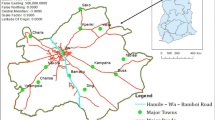Abstract
The reform of spatial planning and land use legislation in South Africa has been difficult to achieve. The laws designed to implement the urban plans of apartheid remain stubbornly in place. This case study shows that despite there having been three windows of opportunity during which far-reaching law reform seemed likely there has been little change. The only post-apartheid national land development law, the Development Facilitation Act, has been found to transgress the Constitutional powers of local government. With its demise the country falls back entirely on pre-democratic planning legislation. Fundamental to effective planning law reform is a constitutional framework that clearly delineates the legislative powers to regulate planning and land use. A clear and shared understanding of what planning can and cannot achieve is also important, as is an effective alignment of planning law reforms with those of other sectoral laws such as local government and environment. Planning law, especially in a country of great inequality, inevitably gives rise to litigation. Drafters of new planning legislation cannot afford not to pay attention to the minutiae of how the planning system operates. Such a failure opens new planning initiatives to legal attack.
Similar content being viewed by others
Notes
For more on the Integrated Development Plan, its origins and impacts, see Harrison in Van Donk et al. (2008).
From 1910 and the establishment of the Union of South Africa four provinces were created from the pre-existing two republics (the Orange Free State and the Transvaal) and the two British colonies (the Cape of Good Hope and Natal). These four provinces continued as the four provinces of the Republic of South Africa established in 1961. In 1910 the planning laws of the old republics and colonies became the laws of the new provinces and remained in force until amended or repealed by the respective provincial governments. After the transition to democracy in 1994 the four provinces were replaced by nine new provinces, resulting in widespread redrawing of provincial boundaries. The laws in place in a particular territory before 1994 however remained in place in that territory afterward, irrespective of the new provincial boundary. Thus, for example, the North West Province established in 1994 has parts of both the old Cape and old Transvaal laws applicable in it (as well as those of the nominally independent pre-1994 Republic of Bophutatswana).
Annexure 1 provides a brief timeline of initiatives from 1993 to the present.
See Harrison et al. (2008), Chapter 2, for more on this process.
Both the Urban Foundation and the Institute for Local Governance and Development ceased to exist shortly after they made these contributions.
This ministry was subsequently renamed the Ministry for Provincial & Local Government and then the Ministry for Cooperative Governance & Traditional Affairs.
Until then the EIA regulations under the 1989 Environment Conservation Act remained in place.
This Department was subsequently renamed the Department for Rural Development and Land Reform.
The Ministry of Housing has been renamed the Ministry for Sustainable Settlements.
Gauteng, Kwazulu-Natal, Northern Cape and Western Cape.
The 1996 Constitution uses the term ‘sphere’ to describe national, provincial and local government, in an endeavour to move away from a hierarchical sense of levels and to promote a more co-operative approach to intergovernmental relations.
Section 146(2)(b) of the Constitution.
Part A of Schedule 5.
The case can be found on www.constitutionalcourt.org.za and the citation for the case is City of Johannesburg v Gauteng Development Tribunal and others 2010 ZACC 11.
Formerly Department for Constitutional Development and then Department for Provincial and Local Government.
The Financial Relations Act, 67 of 1976, Schedule 2, section 14. This definition fell away with the advent of the new constitutional dispensation in 1996.
See Chapter 10 in Harrison et al. (2008).
References
Berrisford, S. (1998). Law and urban change in the New South Africa. In E. Fernandes & A. Varley (Eds.), Illegal cities: Law and urban change in developing countries (pp. 213–229). London: Zed Books.
Berrisford, S. (2004) Modernising and Rationalising the Planning Regulatory Environment. Pretoria: National Treasury.
Harrison, P., Todes, A., & Watson, V. (2008). Planning and transformations: Learning from the post-apartheid experience. Abingdon: Routledge.
Mabin, A., & Smit, D. (1997). Reconstructing South Africa’s cities: The making of urban planning 1900–2000. Planning Perspectives, 12, 193–223.
Parnell, S. (1993). Creating racial privilege: the origins of South African public health and town planning legislation. Journal of Southern African Studies, 19(3), 471–488.
Smit, D. (2008). Modernising and Rationalising the Planning Regulatory Environment. Pretoria: National Treasury.
Turok, I. (1994). Urban planning in the transition from apartheid: Part 1. The legacy of control. Town Planning Review, 65(3), 243–58.
Van Donk, M., Swilling, M., Pieterse, E., & Parnell, S. (2008). Consolidating developmental local government: Lessons from the South African experience. Cape Town: UCT.
Van Wyk, J. (1999). Planning law: Principles, procedures and land-use management. Cape Town: Juta.
Acknowledgments
This article was made possible by funding provided by the Rockefeller Foundation, via the African Centre for Cities, for which I am very grateful. Practical support from the Department of Town & Regional Planning at the University of Sheffield where I was a Visiting Scholar from January to June 2010 was invaluable.
Author information
Authors and Affiliations
Corresponding author
Rights and permissions
About this article
Cite this article
Berrisford, S. Unravelling Apartheid Spatial Planning Legislation in South Africa. Urban Forum 22, 247–263 (2011). https://doi.org/10.1007/s12132-011-9119-8
Published:
Issue Date:
DOI: https://doi.org/10.1007/s12132-011-9119-8




